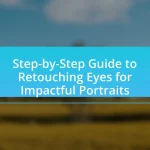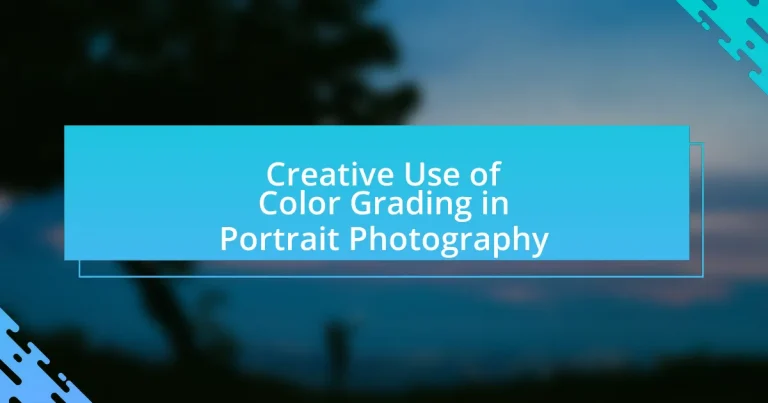The article focuses on the creative use of color grading in portrait photography, emphasizing its role in enhancing emotional impact and aesthetic appeal. It explores how color grading influences mood, psychological effects of different color palettes, and techniques for enhancing subjects’ features. Additionally, the article discusses the importance of color grading in storytelling, differentiating a photographer’s style, and common mistakes to avoid. It also provides practical steps for effective color grading, tips for developing a consistent style, and resources for learning advanced techniques.
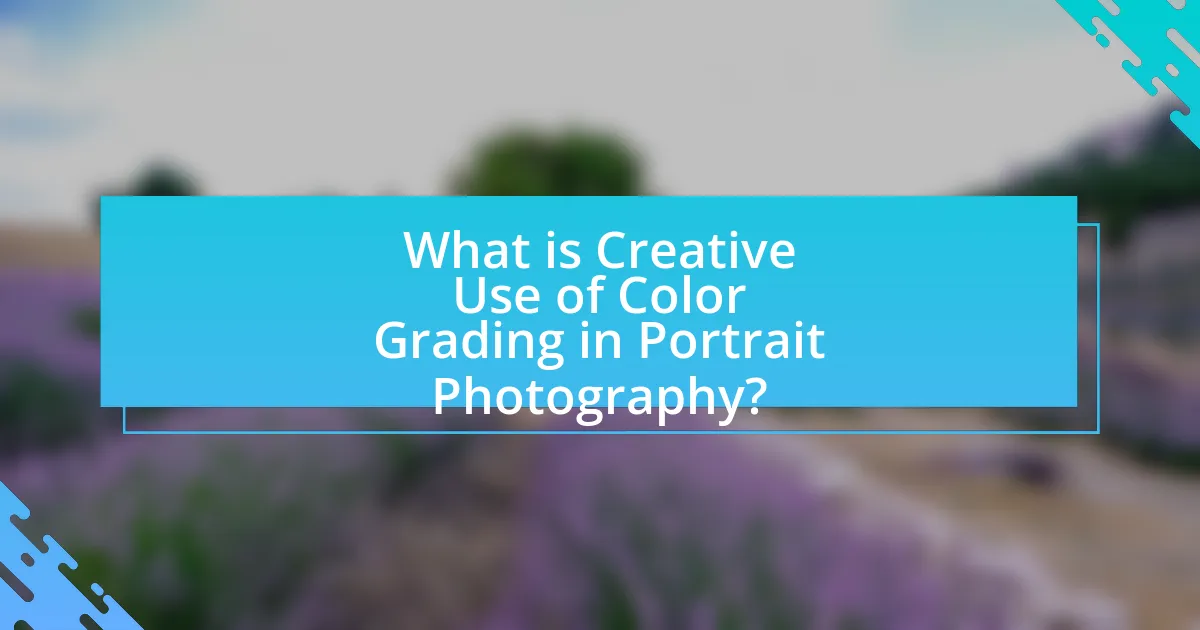
What is Creative Use of Color Grading in Portrait Photography?
Creative use of color grading in portrait photography involves manipulating colors to enhance the emotional impact and aesthetic appeal of the images. This technique allows photographers to create specific moods, highlight subjects, and differentiate their work through unique color palettes. For instance, a warm color grading can evoke feelings of nostalgia, while cooler tones may convey calmness or detachment. Studies have shown that color can significantly influence viewer perception and emotional response, making color grading a powerful tool in visual storytelling.
How does color grading influence the mood of a portrait?
Color grading significantly influences the mood of a portrait by altering the emotional perception through color tones and contrasts. For instance, warm tones like reds and oranges can evoke feelings of warmth and intimacy, while cooler tones such as blues and greens may create a sense of calmness or melancholy. Research indicates that color psychology plays a crucial role in how viewers interpret images; for example, a study published in the Journal of Experimental Psychology found that colors can elicit specific emotional responses, reinforcing the idea that color grading is a powerful tool in visual storytelling.
What are the psychological effects of different color palettes?
Different color palettes can evoke specific psychological effects that influence emotions and perceptions. For instance, warm colors like red and orange can stimulate feelings of warmth, excitement, and energy, while cool colors such as blue and green often promote calmness, tranquility, and relaxation. Research indicates that red can increase heart rates and create a sense of urgency, while blue is associated with stability and trustworthiness. Additionally, yellow can evoke happiness and optimism, but excessive use may lead to anxiety. These effects are supported by studies in color psychology, such as those conducted by Andrew Elliot and Markus Maier, which demonstrate how colors can significantly impact mood and behavior.
How can color grading enhance the subject’s features?
Color grading can enhance the subject’s features by adjusting the tones and contrasts in an image, making specific attributes more prominent. For instance, warmer tones can highlight skin textures and create a healthy glow, while cooler tones can emphasize the eyes and hair, drawing attention to these features. Studies in visual perception indicate that color temperature influences emotional responses, which can further enhance the viewer’s connection to the subject. By strategically applying color grading techniques, photographers can create a more flattering representation of the subject, ultimately improving the overall impact of the portrait.
Why is color grading important in portrait photography?
Color grading is important in portrait photography because it enhances the emotional impact and visual appeal of the images. By adjusting colors, photographers can create a specific mood or atmosphere that resonates with the viewer, making the portrait more engaging. For instance, warmer tones can evoke feelings of comfort and intimacy, while cooler tones may convey a sense of calm or detachment. Studies have shown that color can significantly influence perception; for example, research published in the Journal of Experimental Psychology indicates that colors can affect emotional responses, which underscores the importance of color grading in effectively communicating the subject’s personality and story.
What role does color grading play in storytelling through portraits?
Color grading plays a crucial role in storytelling through portraits by influencing the emotional tone and atmosphere of the image. It allows photographers to manipulate colors to evoke specific feelings, enhance character traits, and convey narrative elements. For instance, warm tones can create a sense of comfort and nostalgia, while cooler tones may evoke sadness or detachment. Research indicates that color psychology significantly impacts viewer perception, with studies showing that colors can alter emotional responses and interpretations of visual content. Thus, effective color grading not only enhances the aesthetic quality of portraits but also deepens the narrative, making it a vital tool in visual storytelling.
How does color grading differentiate a photographer’s style?
Color grading differentiates a photographer’s style by establishing a unique visual aesthetic that reflects their artistic vision and emotional intent. This process involves adjusting the colors, contrast, and brightness of an image to create a specific mood or atmosphere, which can significantly influence how viewers perceive the photograph. For instance, a photographer who consistently uses warm tones may evoke feelings of nostalgia or comfort, while another who opts for cooler hues might convey a sense of calm or detachment. The distinct choices in color grading not only enhance the narrative of the images but also create a recognizable signature that sets one photographer apart from others in the industry.
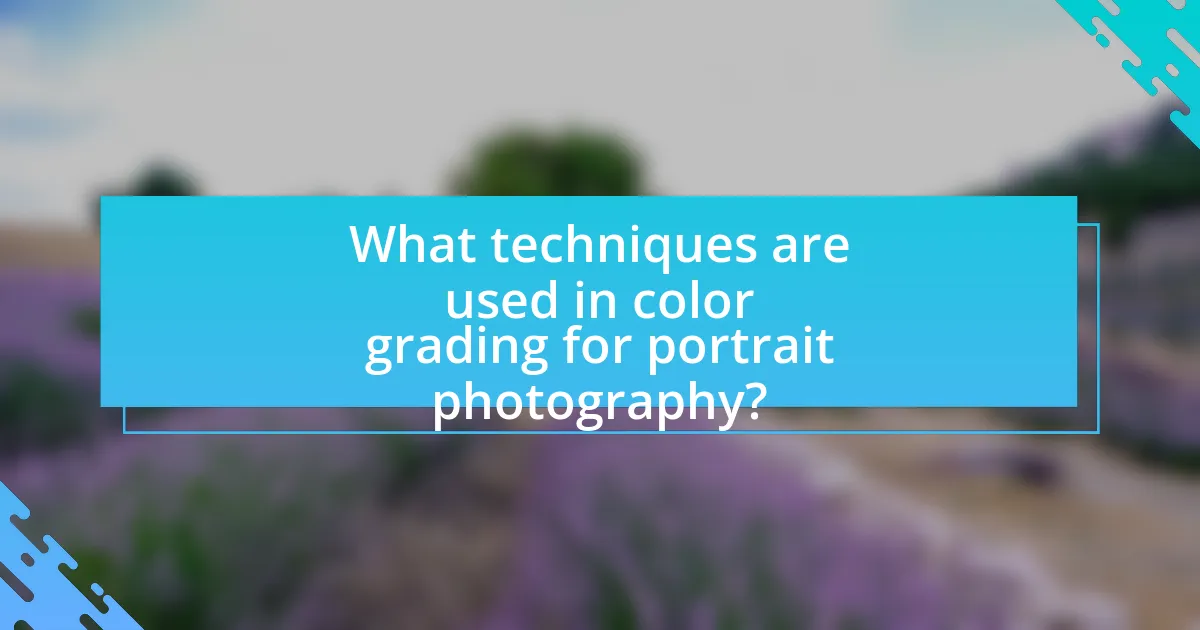
What techniques are used in color grading for portrait photography?
Color grading in portrait photography employs techniques such as color correction, selective color adjustments, and the use of LUTs (Look-Up Tables). Color correction ensures that skin tones appear natural and consistent by adjusting the white balance and exposure. Selective color adjustments allow photographers to enhance specific colors, such as making skin tones warmer or backgrounds cooler, which can create a desired mood or aesthetic. The application of LUTs provides a quick way to apply a specific color palette or style, streamlining the grading process while maintaining a professional look. These techniques collectively enhance the visual appeal of portraits, making them more engaging and artistically expressive.
How can photographers achieve specific color grading effects?
Photographers can achieve specific color grading effects by utilizing software tools like Adobe Lightroom or Photoshop to manipulate color tones and contrasts. These tools allow photographers to adjust hue, saturation, and luminance for individual colors, enabling them to create desired moods or styles in their portraits. For instance, applying a teal and orange color scheme can evoke a cinematic feel, while desaturating certain colors can create a vintage look. The effectiveness of these techniques is supported by the fact that color grading can significantly influence viewer perception and emotional response, as demonstrated in studies on color psychology in visual media.
What tools and software are commonly used for color grading?
Commonly used tools and software for color grading include DaVinci Resolve, Adobe Premiere Pro, and Final Cut Pro. DaVinci Resolve is renowned for its advanced color correction capabilities and is widely used in the film industry. Adobe Premiere Pro integrates well with Adobe’s ecosystem, offering robust color grading tools. Final Cut Pro is favored by many Mac users for its intuitive interface and powerful color grading features. These software options are essential for achieving professional-quality color grading in portrait photography.
How do different color grading techniques affect the final image?
Different color grading techniques significantly influence the final image by altering its mood, depth, and visual appeal. For instance, techniques such as desaturation can create a more somber or nostalgic atmosphere, while vibrant color grading enhances energy and liveliness. Additionally, the use of complementary colors can improve contrast and draw attention to the subject, making it stand out more prominently. Research indicates that color grading can affect viewer emotions; a study published in the Journal of Vision found that specific color combinations can evoke distinct emotional responses, thereby reinforcing the importance of color choices in photography.
What are the common mistakes in color grading portraits?
Common mistakes in color grading portraits include over-saturation, incorrect skin tone adjustments, and neglecting contrast. Over-saturation can lead to unnatural colors that distract from the subject, while incorrect skin tone adjustments can result in unflattering hues that misrepresent the subject’s complexion. Neglecting contrast often results in flat images that lack depth and dimension, making the portrait less engaging. These mistakes can significantly diminish the overall quality and impact of the portrait, highlighting the importance of careful and thoughtful color grading techniques.
How can over-saturation impact the quality of a portrait?
Over-saturation can significantly degrade the quality of a portrait by distorting skin tones and creating an unnatural appearance. When colors are excessively intensified, the subtle variations in skin tones can be lost, leading to a flat and unrealistic representation of the subject. This effect can detract from the overall aesthetic appeal of the portrait, making it less relatable and visually jarring. Studies in color theory indicate that balanced saturation enhances visual harmony, while over-saturation disrupts it, resulting in a less effective portrayal of the subject’s features and emotions.
What are the signs of poor color grading in portrait photography?
Signs of poor color grading in portrait photography include unnatural skin tones, excessive color casts, and lack of contrast. Unnatural skin tones often result from incorrect white balance adjustments, leading to overly warm or cool hues that do not reflect reality. Excessive color casts can manifest as dominant colors that overshadow the subject, detracting from the overall image quality. Additionally, a lack of contrast may cause portraits to appear flat and lifeless, as the tonal range fails to highlight the subject’s features effectively. These issues can significantly diminish the visual appeal and emotional impact of the portrait.
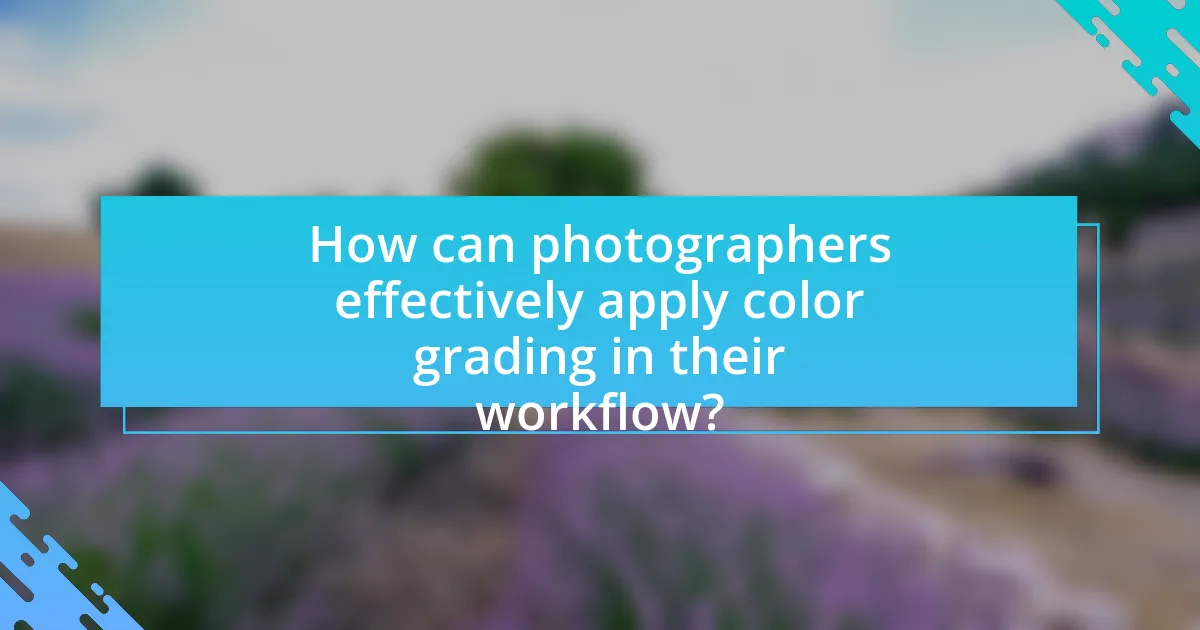
How can photographers effectively apply color grading in their workflow?
Photographers can effectively apply color grading in their workflow by utilizing software tools like Adobe Lightroom or DaVinci Resolve to adjust color balance, saturation, and contrast. These tools allow photographers to create a consistent color palette that enhances the mood and style of their portraits. For instance, using the HSL (Hue, Saturation, Luminance) panel in Lightroom enables precise control over individual colors, allowing for targeted adjustments that can dramatically alter the visual impact of an image. Studies show that color grading can influence viewer emotions and perceptions, making it a critical component in portrait photography.
What steps should photographers follow for successful color grading?
Photographers should follow a systematic approach for successful color grading, which includes the following steps: first, they should assess the image’s overall tone and mood to determine the desired color palette. Next, they should adjust the white balance to ensure accurate color representation. After that, photographers should utilize color wheels or sliders to manipulate shadows, midtones, and highlights, enhancing specific colors to achieve the intended effect. Following this, they should apply selective color adjustments to emphasize or mute certain hues, ensuring harmony within the image. Finally, they should review the final output on calibrated monitors to confirm that the colors appear as intended across different devices. This structured process is essential for achieving professional and visually appealing results in portrait photography.
How can photographers develop a consistent color grading style?
Photographers can develop a consistent color grading style by establishing a defined color palette and applying it uniformly across their work. This involves selecting specific hues, saturation levels, and contrast settings that align with their artistic vision. By using software tools like Adobe Lightroom or Photoshop, photographers can create presets that encapsulate their chosen style, ensuring that each image maintains a cohesive look. Research indicates that consistency in color grading enhances brand identity and viewer recognition, as seen in studies on visual marketing strategies.
What are the best practices for color grading in post-production?
The best practices for color grading in post-production include establishing a clear vision for the desired mood, utilizing color wheels and curves for precise adjustments, and maintaining consistency across shots. Establishing a vision helps guide the grading process, ensuring that colors align with the intended emotional tone of the portrait. Utilizing color wheels allows for targeted adjustments to shadows, midtones, and highlights, while curves provide control over contrast and brightness. Consistency is crucial, as it ensures that the overall aesthetic remains cohesive throughout the series of portraits. These practices are supported by industry standards, such as the use of color grading software like DaVinci Resolve, which is widely recognized for its powerful tools that facilitate these techniques.
What tips can enhance the creative use of color grading in portraits?
To enhance the creative use of color grading in portraits, photographers should focus on understanding color theory and its emotional impact. Utilizing complementary colors can create striking contrasts that draw attention to the subject, while analogous colors can evoke harmony and warmth. Additionally, adjusting the saturation and luminance of specific colors can help emphasize the subject’s features and mood. For instance, desaturating the background while keeping the subject vibrant can create a compelling focal point. Studies show that color grading can significantly influence viewer perception, making it a powerful tool in portrait photography.
How can photographers experiment with color grading to find their unique style?
Photographers can experiment with color grading by utilizing various software tools to manipulate hues, saturation, and contrast, allowing them to develop a distinctive visual style. By applying different color grading techniques, such as split toning, color balance adjustments, and LUTs (Look-Up Tables), photographers can create mood and atmosphere that resonate with their artistic vision. For instance, a study by the American Society of Media Photographers highlights that color grading can significantly influence viewer perception and emotional response, underscoring its importance in establishing a unique photographic identity.
What resources are available for learning advanced color grading techniques?
Online courses such as those offered by MasterClass, Udemy, and LinkedIn Learning provide structured learning paths for advanced color grading techniques. These platforms feature courses taught by industry professionals, covering software like DaVinci Resolve and Adobe Premiere Pro, which are widely used in the field. Additionally, YouTube channels like Film Riot and Color Grading Central offer free tutorials that delve into specific techniques and workflows. Books such as “Color Correction Handbook” by Alexis Van Hurkman serve as comprehensive guides, detailing both theory and practical applications of color grading. These resources collectively equip learners with the necessary skills and knowledge to master advanced color grading in portrait photography.




